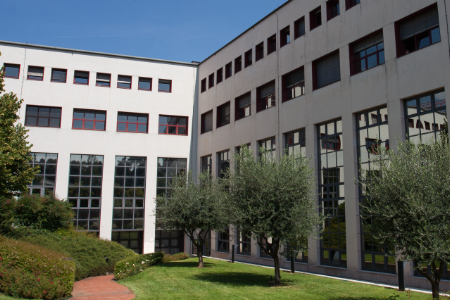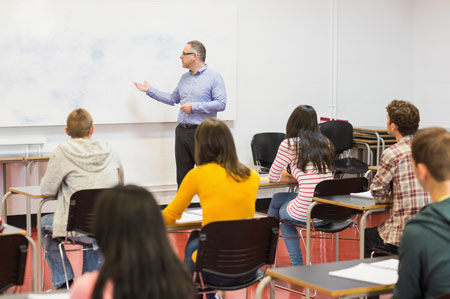Course not running
- Course code
- 4S001198
-
Name of lecturer
-
Alfredo Buonopane
- Number of ECTS credits allocated
-
4
- Academic sector
-
L-ANT/03 - ROMAN HISTORY
- Language of instruction
- Italian
- Period
-
Sem. 1B dal Nov 19, 2018 al Dec 21, 2018.
To show the organization of the course that includes this module, follow this link  Course organization
Course organization
Lesson timetable
Go to lesson schedule
Learning outcomes
1. Knowledge and understanding:
By the end of the course the students will be able to:
- identify and explain the basic concepts concerning the teaching of Ancient History;
- identify and explain the main facts and issues relating to Ancient History, particularly Greek and Roman History.
2. Applying knowledge and understanding:
By the end of the course the students will be able to:
- apply the knowledge gained during lectures in order to define their teaching activities and to promote the child's interest in History.
3. Making judgements:
By the end of the course the students will be able to:
- approach historical research critically.
4. Communication skills:
By the end of the course the students will be able to:
- use language clearly, including technical terms taken from historical research.
5. Learning skills:
By the end of the course the students will be able to:
- find and use historical sources, suitable for developing appropriate learning and teaching strategies.
Syllabus
REQUIREMENTS
Students should have a basic knowledge of general history, from the Prehistory to Modern History;
Students should be able to speak and write a good Italian.
CONTENTS
The course contents regard:
A) Greek and Roman History: II millennium BC; the Dark Ages; the Archiac Age; the polis; the Classical Age; Athens and Sparta; the decline of the polis; Alexander the Great; the Roman kings; the Republican Rome and its expansion; the Imperial Rome; the spread of Christianity.
B) Theories of historical research and teaching of Ancient History.
TEACHING METHODS
Lectures in which examples (also taken from the professional context of Infant and Primary Schools) will be presented and discussed to support the teaching/learning of the discipline's basic concepts.
TEXTS
1) Greek History: M. Bettalli – A.L. D’Agata – A. Magnetto, Storia greca, Carocci, Roma 2013;
2) Roman History: G. Cresci Marrone – F. Rohr Vio – L. Calvelli, Roma antica, Il Mulino, Bologna 2014;
3) Teaching of Ancient History: W. Panciera, Insegnare storia nella scuola primaria e dell’infanzia, Carocci, Roma 2016;
4) Notes taken during lectures.
Erasmus students: please, email me as soon as possible.
Assessment methods and criteria
Learning assessment method
The assessment method will be NO different for attending and non-attending students.
Learning levels will be assessed by a written examination.
Students must be able to demonstrate:
- to have acquired a basic knowledge of Ancient History;
- to have acquired a critical method of understanding historical facts and problems;
- to have understood the most important concepts and theories concerning the teaching of Ancient History;
- to be able to express their own reasoning precisely and in a limited amount of time, identifying and selecting the essential elements.
Results
The results of the examination will be given on a scale of thirty.
Syllabus
REQUIREMENTS
Students should have a basic knowledge of general history, from the Prehistory to Modern History;
Students should be able to speak and write a good Italian.
CONTENTS
The course contents regard:
A) Greek and Roman History: II millennium BC; the Dark Ages; the Archiac Age; the polis; the Classical Age; Athens and Sparta; the decline of the polis; Alexander the Great; the Roman kings; the Republican Rome and its expansion; the Imperial Rome; the spread of Christianity.
B) Theories of historical research and teaching of Ancient History.
TEACHING METHODS
Lectures in which examples (also taken from the professional context of Infant and Primary Schools) will be presented and discussed to support the teaching/learning of the discipline's basic concepts.
TEXTS
1) Greek History: M. Bettalli – A.L. D’Agata – A. Magnetto, Storia greca, Carocci, Roma 2013;
2) Roman History: G. Cresci Marrone – F. Rohr Vio – L. Calvelli, Roma antica, Il Mulino, Bologna 2014;
3) Teaching of Ancient History: W. Panciera, Insegnare storia nella scuola primaria e dell’infanzia, Carocci, Roma 2016;
4) Notes taken during lectures.
Erasmus students: please, email me as soon as possible.
Reference books
| Author |
Title |
Publisher |
Year |
ISBN |
Note |
| W. Panciera |
Insegnare storia nella scuola primaria e dell’infanzia
|
Carocci |
2016
|
|
|
| G. Cresci Marrone, F. Rohr Vio, L. Calvelli |
Roma antica. Storia e documenti
(Edizione 1)
|
Il Mulino |
2014
|
9788815251770 |
|
| M. Bettalli - A.L. D’Agata - A. Magnetto |
Storia greca
|
Carocci |
2013
|
|
|
Assessment methods and criteria
Learning assessment method
The assessment method will be NO different for attending and non-attending students.
Learning levels will be assessed by a written examination.
Students must be able to demonstrate:
- to have acquired a basic knowledge of Ancient History;
- to have acquired a critical method of understanding historical facts and problems;
- to have understood the most important concepts and theories concerning the teaching of Ancient History;
- to be able to express their own reasoning precisely and in a limited amount of time, identifying and selecting the essential elements.
Results
The results of the examination will be given on a scale of thirty.
- avere acquisito adeguata capacità di interpretare criticamente i fatti storici, ai fini di una loro successiva
STUDENT MODULE EVALUATION - 2017/2018








